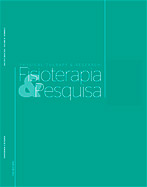Effect of age, dual task and vision on the sense of ankle positioning
DOI:
https://doi.org/10.1590/1809-2950/17000925042018Keywords:
Proprioception, Elderly, Adult, Postural Balance, Accidental FallsAbstract
The objective of this research was to measure objectively the proprioception in different situations (with and without the aid of vision, with or without a concomitant cognitive task, and actively and passively), in elder and adult individuals. Ten healthy adults and ten healthy seniors participated in the study. The effects of different restrictions were studied in the development of movement through absolute (accuracy) and relative (consistency) errors. The sense of ankle positioning was measured with a Biodex System 3isokinetic dynamometer. Four-factor analysis of variance and the Tukey post hoc test were used to analyze the parameters. The results showed that the subject factor interferes in the absolute error, since the groups showed significant difference: the elderly make more mistakes when compared with adults. The other factors (vision, cognitive task and type of movement) did not show significant difference. In the relative error, results showed that the cognitive task concomitant to movement was capable of producing significant difference; however, the other factors (individuals, vision and type of movement) were not. Age affects the accuracy of the proprioceptive sense, regardless of the situation. There was no difference between performing the movement with and without the aid of vision, and the double task (motor associated with cognitive) affects the consistency of the movement.
Downloads
References
Rahal MA, Alonso AC, Andrusaitis FR, Rodrigues TS, Speciali
DS, D’Andréa Greve JM, et al. Analysis of static and dynamic
balance in healthy elderly practitioners of Tai Chi Chuan versus
ballroom dancing. Clinics. 2015;70(3):157-61. doi: 10.6061/
clinics/2015(03)01
Serra MM, Alonso AC, Peterson M, Mochizuki L, Greve JMDA,
Garcez-Leme LE. Balance and muscle strength in elderly women
who dance samba. PLOS ONE. 2016;11(12):e0166105. doi: 10.1371/
journal.pone.0166105
Alonso AC, Luna NMS, Mochizuki L, Barbieri F, Santos S, Greve
JM. The influence of anthropometric factors on postural balance:
the relationship between body composition and posturographic
measurements in young adults. Clinics. 2012;67(12):1433-41.
doi: 10.6061/clinics/2012(12)14
Alonso AC, Luna NM, Dionísio FN, Speciali DS, GarcezLeme LE, Greve JMD. Functional balance assessment:
review. MedicalExpress. 2014;1(6):298-301. doi: 10.5935/
MedicalExpress.2014.06.03
Shumway-Cook A, Woollacott MH. Motor control: theory and
practical applications. 2nd ed. Baltimore, MD: Lippincott Williams
& Wilkins; 2001.
Ribeiro F, Oliveira J. Effect of physical exercise and age on knee
joint position sense. Arch Gerontol Geriatr. 2010;51(1):64-7.
doi: 10.1016/j.archger.2009.07.006
Pupo STM, Bastos CS, Silva SP, Santos CAS, Alonso AC, SabbagSilva A. Avaliação do senso de posicionamento articular em
adultos idosos com e sem diagnóstico de osteoartrose na
região do joelho. Fisioter Bras. 2015;16(3):212-7
Jamet M, Deviterne D, Gauchard GC, Vançon G, Perrin
PP. Higher visual dependency increases balance control
perturbation during cognitive task fulfillment in elderly
people. Neurosci Lett. 2004;359(1-2):61-4. doi: 10.1016/j.
neulet.2004.02.010
Maylor EA, Allison S, Wing AM. Effects of spatial and nonspatial
cognitive activity stability. Br J Psychol. 2001;92(2):319-38.
Asimakopulos J, Boychuck Z, Sondergaard D, Poulin V,
Ménard I, Korner-Bitensky N. Assessing executive function in
relation to fitness to drive: a review of tools and their ability
to predict safe driving. Aust Occup Ther J. 2012;59(6):402-27.
doi: 10.1111/j.1440-1630.2011.00963.x
Alonso AC, Peterson MD, Busse AL, Jacob-Filho W, Borges MT,
Serra MM, et al. Muscle strength, postural balance, and cognition
are associated with braking time during driving in older adults.
Exp Gerontol. 2016;85:13-7. doi: 10.1016/j.exger.2016.09.006
Al-Yahya E, Dawes H, Smith L, Dennis A, Howells K, Cockburn J.
Cognitive motor interference while walking: a systematic review
and meta-analysis. Neurosci Biobehav Rev. 2011;35(3):715-28.
doi: 10.1016/j.neubiorev.2010.08.008
Johansson J, Nordström A, Nordström P. Greater fall risk
in elderly women than in men is associated with increased
gait variability during multitasking. J Am Med Dir Assoc.
;17(6):535-40. doi: 10.1016/j.jamda.2016.02.009
Barbosa JMM, Prates BSS, Gonçalves CF, Aquino AR, Parentoni AN.
Efeito da realização simultânea de tarefas cognitivas e motoras no
desempenho funcional de idosos da comunidade. Fisioter Pesqui.
;15(4):374-9. doi: 10.1590/S1809-29502008000400010
Deshpande N, Simonsick E, Metter EJ, Ko S, Ferrucci L, Studenski
S. Ankle proprioceptive acuity is associated with objective
as well as self-report measures of balance, mobility, and
physical function. Age (Dordr). 2016;38(3):53. doi: 10.1007/
s11357-016-9918-x
Downloads
Published
Issue
Section
License
Copyright (c) 2018 Fisioterapia e Pesquisa

This work is licensed under a Creative Commons Attribution-ShareAlike 4.0 International License.



